The US dollar decline sparks pessimism, leaving investors worried about what lies ahead. Amidst increasing pessimism and souring sentiment, experts are predicting that the worst may be yet to come for the once-dominant currency.
US Dollar Decline: Reasons and Ramifications
The US dollar, once revered as the world’s primary reserve currency, has encountered significant challenges over the years. However, recent events have accelerated its decline, raising alarm bells among investors and market participants alike. Notably, Jason Goepfert, the renowned analyst at SentimenTrader, has highlighted a critical development – the dollar’s Optimism Index has plummeted below 40, marking the first time in two years.
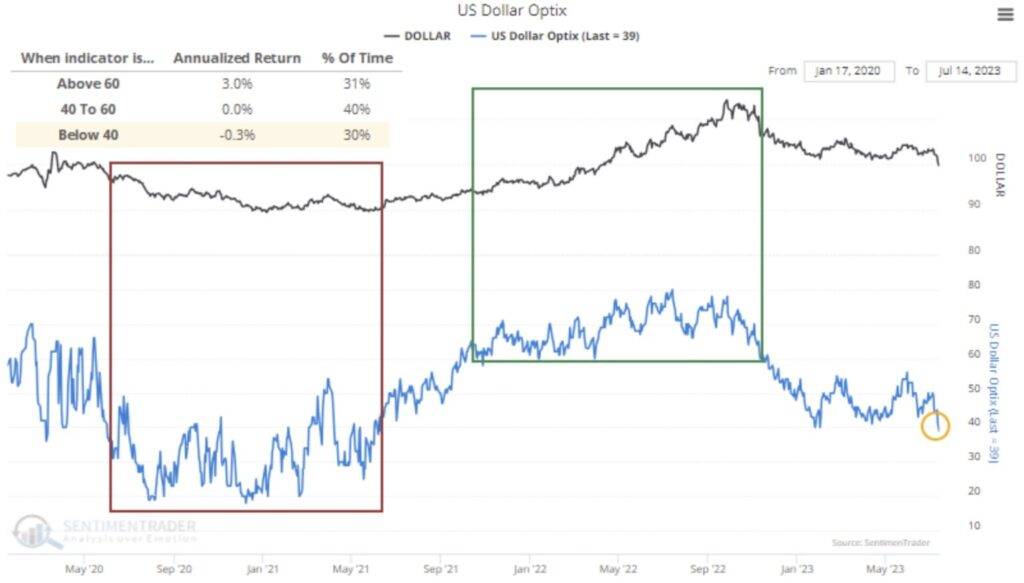
Source: kingworldnews
This sharp drop in market confidence has put dollar bulls on the defensive. History has shown that when sentiment turns bearish on a currency, the downward trend tends to persist, making a swift recovery improbable. Investors are now grappling with the realization that the dollar’s journey to regain its former strength might be fraught with challenges.
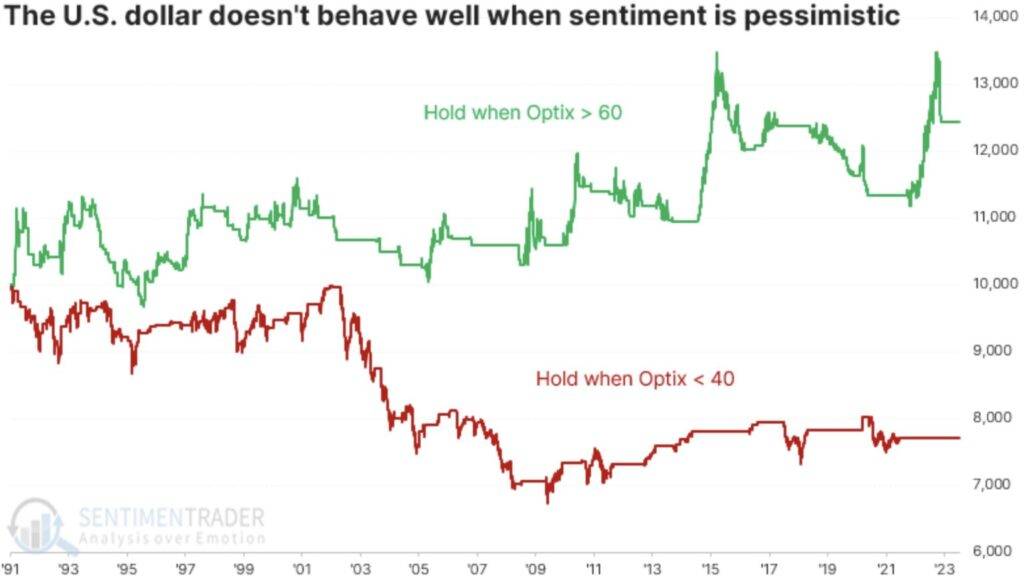
The dollar’s status as a reserve currency has been pivotal in shaping global trade and financial markets. However, with its recent slide, concerns have deepened over its capacity to maintain its standing and how this downturn might impact economies and financial systems worldwide. The dollar’s significance as a safe-haven asset and a benchmark for international transactions adds to the complexity of the situation.
Geopolitical and macroeconomic factors have significantly contributed to the dollar’s recent struggles. Uncertainties surrounding trade policies, geopolitical tensions, and divergent monetary policies among central banks have all played a role in shaping market sentiment. The shifting dynamics in the global economy, including the rise of emerging markets and changes in trade relationships, have also contributed to the dollar’s weakened position.
Moreover, the era of low-interest rates and massive liquidity injections by central banks has affected the dollar’s value. As investors seek higher returns in riskier assets, they might shy away from traditional safe-havens like the US dollar. Consequently, the dollar’s value has been under pressure, leading to a challenging environment for traders and investors.
Historic 5-day Decline and its Impact
The US dollar’s recent historic 5-day decline has created a highly turbulent and uncertain environment in the financial markets. Investors and market participants are closely monitoring the dollar’s sharp depreciation, which surpassed 3% during this brief period, leading the currency to hit its lowest level in over a year. Such a rapid and substantial drop in value is a cause for concern, as it indicates a weakening sentiment and lack of confidence in the dollar’s strength.
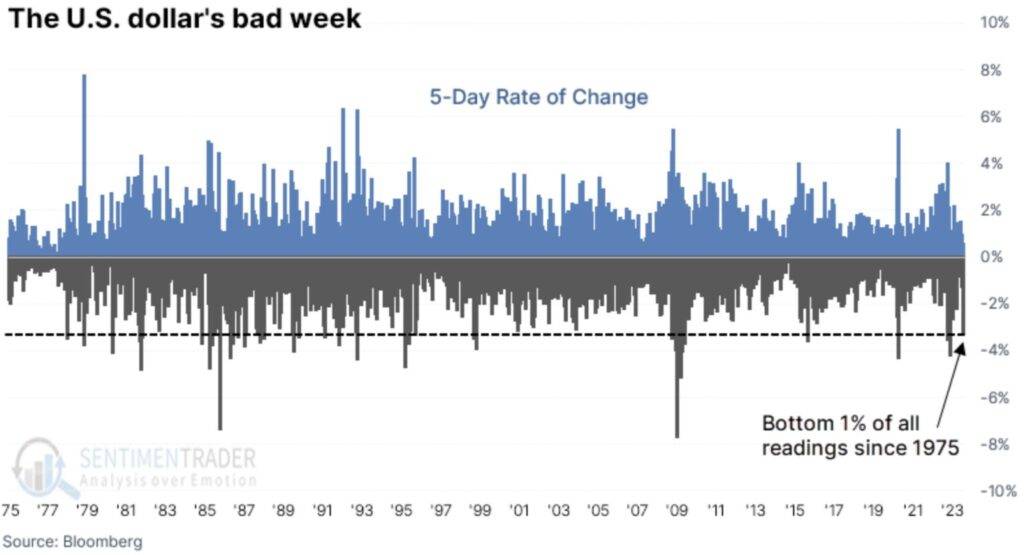
Historical data analysis further compounds the worries surrounding the dollar’s outlook. When examining past occurrences where the dollar experienced a one-week decline of this magnitude and reached a 52-week low, the results are far from encouraging. Over the next 2-12 weeks, the dollar managed to recover in just 26% of cases, leaving a majority of instances with the currency continuing its downward trend. Moreover, the risk involved in holding on to the dollar during this period was substantially higher than the potential rewards, making it a challenging environment for investors seeking stable returns.
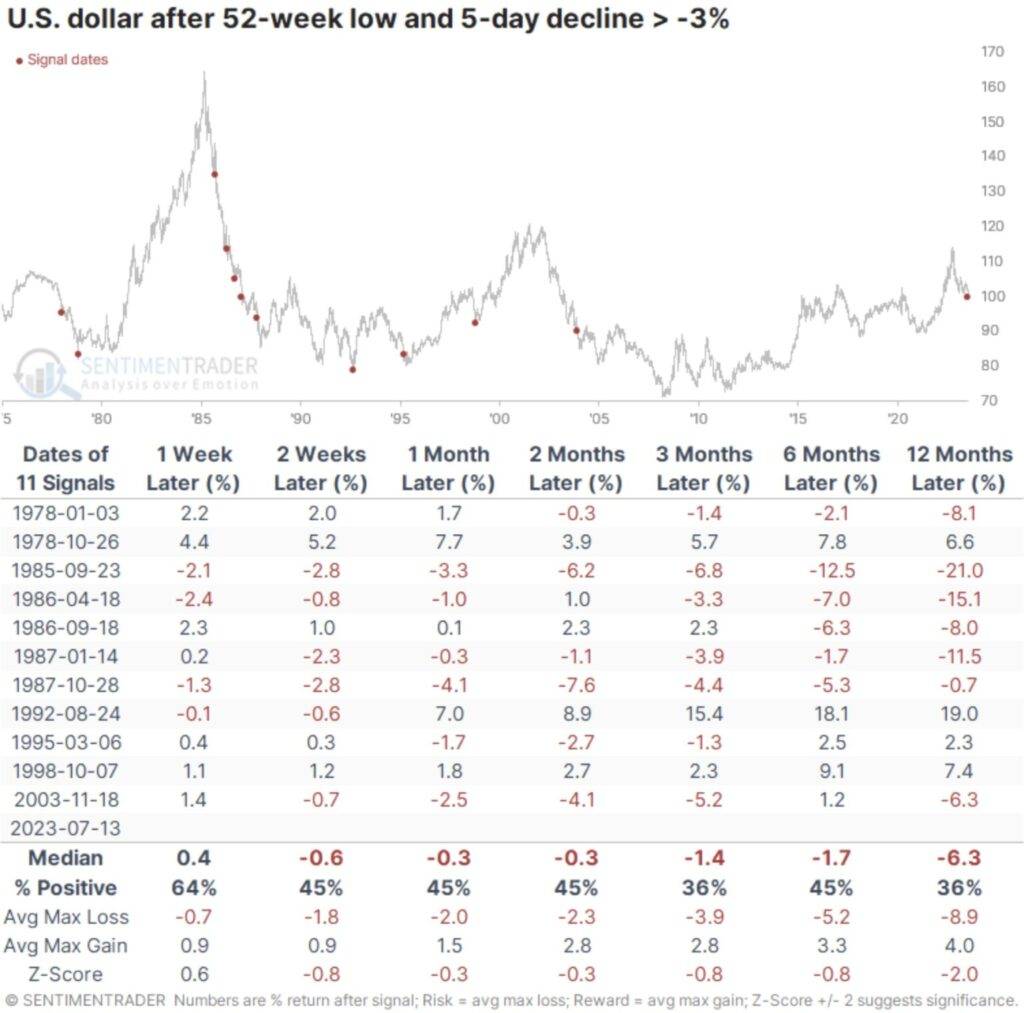
The repercussions of the dollar’s historic decline extend beyond the currency market. A weak dollar can have profound implications for various asset classes and global economic dynamics. Investors are closely observing how this trend might affect global trade, commodity prices, and currency valuations. Moreover, economies heavily reliant on dollar-denominated debt, especially in emerging markets, may face challenges in servicing their obligations, which could pose financial stability risks.
In the investment landscape, the dollar’s decline is likely to impact asset allocation decisions. Assets denominated in other currencies, such as commodities and international stocks, may become more attractive for dollar investors as they become cheaper. Conversely, US-based assets might face headwinds, potentially affecting portfolios and investment strategies.
Market Response to Dollar’s Downturn
The market response to the US dollar’s downturn has been a mixed bag, with certain asset classes reaping benefits from the currency’s weakness. Notably, major stock indexes, such as the Nasdaq Composite and Russell 2000, have shown significant gains after the dollar’s decline. This trend suggests that stocks have emerged as winners amidst the dollar’s struggles, attracting investors seeking growth opportunities during this volatile period.
Internationally, the MSCI Emerging Markets Index has demonstrated remarkable resilience following the dollar’s decline. Over the next three months after such events, the index has recorded a median return of +12.2%, with nine out of 12 signals resulting in positive gains. This phenomenon underscores the attractiveness of international markets during the dollar’s challenging times, offering promising potential for investors who are diversifying their portfolios beyond US borders.
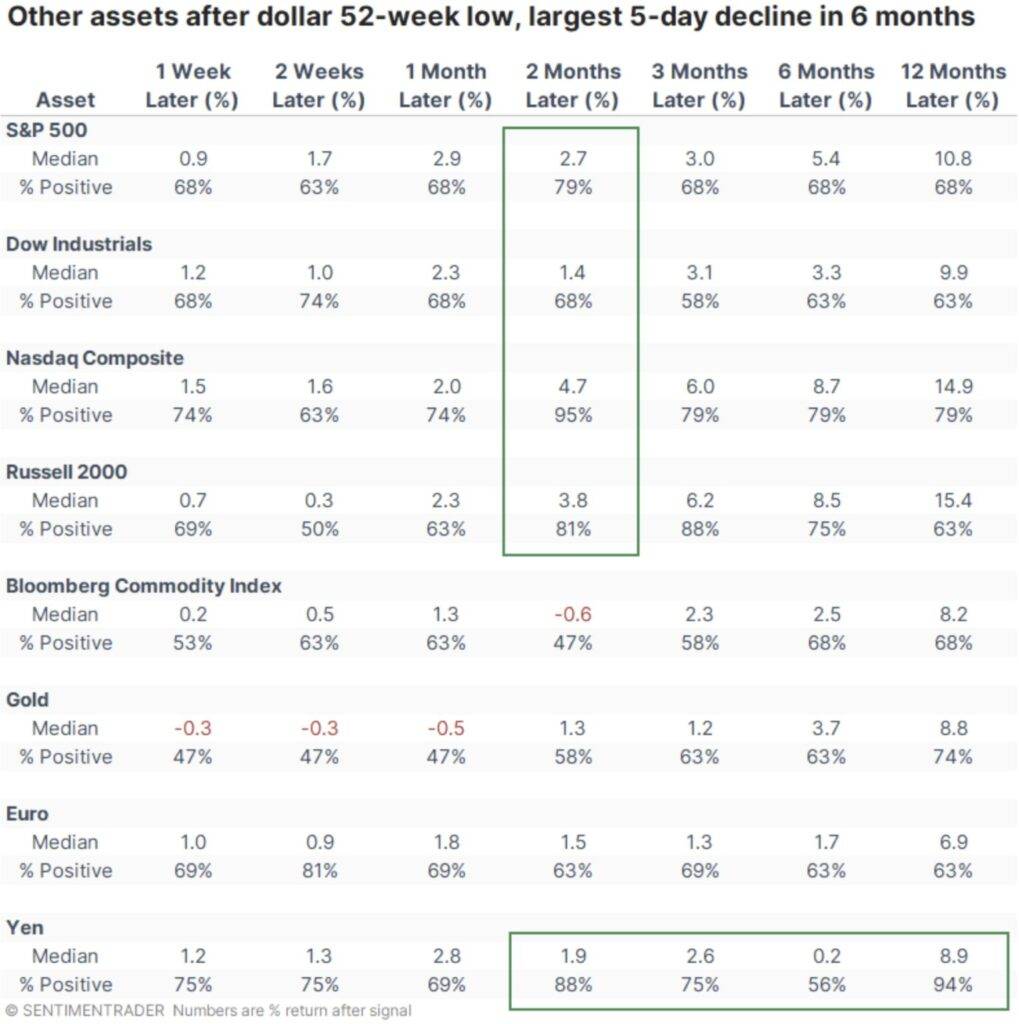
The positive response of stocks and international markets to the dollar’s downturn highlights the importance of global diversification for investors seeking to mitigate risks and capitalize on various growth opportunities. By allocating investments across different asset classes and geographic regions, investors can potentially benefit from a balanced and robust portfolio, even amidst currency fluctuations and market uncertainties.
However, despite the potential benefits in certain areas of the market, investors should exercise caution and conduct thorough research before making investment decisions. Market conditions can change rapidly, and risks are inherent in all investments. Prudent risk management and a long-term investment perspective are essential for navigating through market volatility and achieving sustainable growth in one’s investment portfolio.
Click here to check the Live US Dollar Index
Understanding Sentiment and Currencies
Sentiment analysis plays a crucial role in predicting market movements, but it may not be as effective in predicting trends in currencies and some commodities. In contrast to stock markets, where market sentiment often follows a mean-reversion pattern, currency sentiment tends to get stuck at mediocre extremes for more extended periods.
This means that while pessimism may persist, the US dollar is likely to face a challenging road to recovery. Investors should keep a close eye on sentiment indicators and expert analyses to make informed decisions in the ever-changing forex market.
Expert Insights and Recommendations
Market expert Jason Goepfert’s data-driven analysis highlights the significance of monitoring sentiment trends for the US dollar. The souring sentiment is not yet at an extreme level, indicating the potential for further declines.
For traders and investors, navigating the forex market amidst the dollar’s historic decline requires caution and well-informed strategies. Understanding the implications of pessimistic sentiment on the dollar and other currencies can guide investment decisions and risk management.
Conclusion: The Dollar’s Journey Ahead
The US dollar’s historic decline has caused uncertainty in the global financial landscape. While optimism on the dollar has faded, the market sentiment has yet to reach extreme levels that could signal a potential trend reversal.
As experts warn that the worst may be yet to come, investors must remain vigilant and adapt their strategies accordingly. Diversifying portfolios with assets that tend to thrive in the wake of the dollar’s decline, such as stocks and international markets, may offer potential opportunities for traders looking to navigate the evolving financial climate.
Understanding sentiment and market dynamics will be crucial in the coming months as the dollar’s trajectory unfolds. By staying informed and relying on expert insights, investors can position themselves prudently in these challenging times.
Click here to read our latest article on Currency Pairs React to UK CPI Miss

